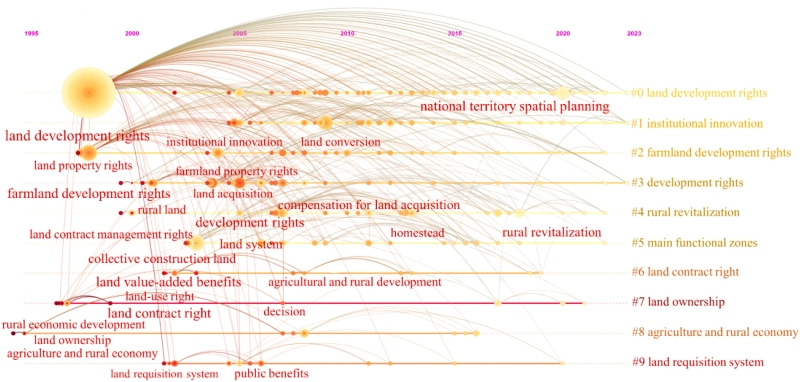Peng Cheng , Yongqin Fan , Houtian Tang , Ke Liu , Shiman Wu , Gaoli Zhu , Ping Jiang , Weili Guo
a School of Management, Wuhan Institute of Technology, Wuhan, 430205, Hubei Province, China
b School of Public Affairs, Xiamen University, Xiamen, 361005, Fujian Province, China
c School of Public Administration, Huazhong Agricultural University, Wuhan, 430070, Hubei Province, China
d School of Public Administration, Nanjing University of Finance & Economics, Nanjing, 210023, Jiangsu Province, China
e School of Resource and Environmental Sciences, Wuhan University, Wuhan, 430079, Hubei Province, China
f Guangxi Institute of Natural Resources Survey and Monitoring, Nanning, 530219, Guangxi Zhuang Autonomous Region, China
Abstract:
Based on the China National Knowledge Infrastructure (CNKI) and Web of Science (WOS) databases, this article analyzes the deductive context, cooperation network, and research hotspots of land development rights (LDR) research in the Chinese and international literature by using CiteSpace software, and it also explores the implications of this research for the theory and practice of national territory spatial planning (NTSP) in China. The results show that (1) the literature on LDR in Chinese and international journal articles initially appeared in 1995 and 1973, respectively, researches in China experienced three stages: embryonic fluctuating development, rapid growth and stable development, and wave development, while international researches experienced two stages: embryonic fluctuating and a gradually increasing development. (2) Among these scholars and research institutions, there is no obvious difference between Chinese and international scholars, while the Renmin University of China and the State University System of Florida are the research institutions with the largest number of Chinese and international journal articles, respectively. (3) In terms of publishing journals, international journals mainly focus on land policy, cities, and resource fields, while Chinese journals mainly focus on the agricultural economy, civil and commercial law, economic systems, and macroeconomic management fields. (4) The direction and scale of thematic research vary greatly, with Chinese research mainly conducted from the perspectives of rights attribution and benefits distribution, while international research mainly focuses on the operation of the right-to-development system and its impact on the environment. In the future, studies focus on China's need to strengthen the research and institutional practice of LDR at the legal level, value level, and extension level following national conditions, formulate a land value-added benefit distribution system with efficiency and fairness, and strengthen the practice of LDR in China's NTSP based on the differences between urban and rural development.
Keywords:
Land development rights; China's national territory spatial planning; Land value-added benefits; Hotspot research; Visual analysis; CiteSpace
